Dachau Trials
US vs. Josias Erbprinz zu Waldeck-Pyrmont
The Trial of Ilse Koch
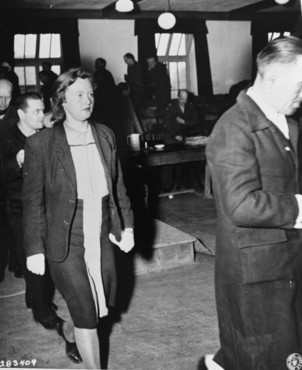
Ilse Koch leaves the
courtroom at Dachau, April 1947
Army Signal Corps photo
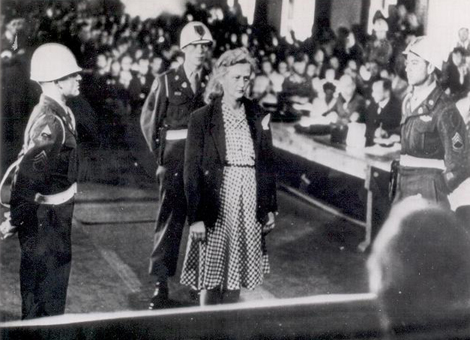
Ilse Koch, August 19,
1947
Photo Credit: INP Soundphoto
The most notorious German war criminal,
of all those who were brought before the American Military Tribunals
at Dachau, was unquestionably Ilse Koch, the wife of Karl Otto
Koch, the infamous former Commandant of the Buchenwald concentration
camp. Karl Otto Koch had already been put on trial by the Nazis
themselves and executed before the war ended. Ilse Koch was among
the 31 accused war criminals from Buchenwald who were brought
before an American Military Tribunal at Dachau on April 11, 1947.
Ilse Koch became pregnant while she was
held in prison at the former Dachau concentration camp. The two
photos above show how she lost weight during the trial; her baby
was born in September 1947.
Frau Koch had been previously investigated
for 8 months by Dr. Georg Konrad Morgen, an SS officer who had
been assigned in 1943 to look into accusations of corruption
and murder in the Buchenwald camp. She had already been put on
trial in December 1943 in a special Nazi Court where Konrad Morgan
was the judge. The rumor, circulated by the inmates at Buchenwald,
that lamp shades had been made out of human skin, was thoroughly
investigated, but no evidence was found and this charge against
Frau Koch had been dismissed by Morgen.
Even though Ilse Koch had been acquitted
in Morgen's court, the former inmates at Buchenwald were convinced
that she had ordered prisoners to be killed, so that their tattooed
skin could be made into lamp shades. When the American liberators
arrived, they were told about the gory accessories in Frau Koch's
home. A display table was set up and a film, directed by Billy
Wilder, was made to document the atrocities in the camp.
The photograph below is a still shot
from the film. It shows preserved pieces of tattooed skin laid
out on a table, and a table lamp with a shade allegedly made
from human skin.
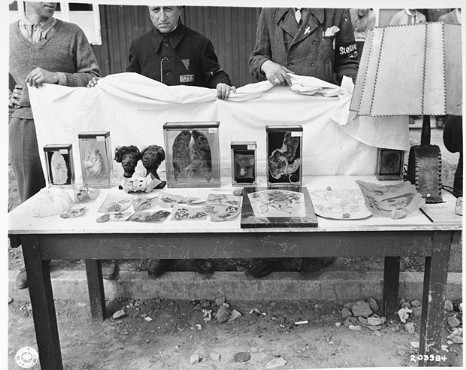
Display table at Buchenwald
was part of the grand tour of the camp
The story of the making of human lampshades
at Buchenwald received a great deal of attention by the American
press, and in the two years between the liberation of the camp
and the start of the Buchenwald trial at Dachau, there had been
considerable coverage in American newspapers.
American soldiers who participated in
the liberation of Buchenwald, including Harry Herder and Sgt.
Blowers, had told horrible stories about the camp which they
had learned from the prisoners. By the time the trial got underway,
there was not the slightest doubt in the minds of most Americans
that Ilse Koch was indeed guilty of this despicable crime.
The following quote is from this web
site.
Sergeant Blowers told us some things
about the Commandant of Buchenwald and his wife. We could see
their house down the hill through the leafless trees from our
seats on the front steps (of the barracks). Blowers painted a
picture of truly despicable human beings. The wife, Ilse Koch,
favored jodhpurs, boots, and a riding crop. He told us this story
about her: Once, she ordered all of the Jewish prisoners in the
camp stripped and lined up; she then marched down the rows of
them, and, as she saw a tattoo she liked, she would touch that
tattoo with her riding crop; the guards would take the man away
immediately to the camp hospital where the doctors would remove
the patch of skin with the tattoo, have it tanned, and patch
it together with others to make lamp shades. There were three
of those lamp shades--the history books say there were two, but
there were three. One of them disappeared shortly after we arrived.
This may give you a glimmer of an idea of what Ilse Koch was
like--and her husband--and the camp "doctors."
Ilse Koch testified that her home was
near the zoo at Buchenwald, which means that her home was up
the hill from the barracks, not "down the hill through the
leafless trees" as described by Sgt. Blowers, which suggests
that he and Harry
Herder may not have been among the liberators of Buchenwald.

Ilse Koch points to
the location of her home near the camp zoo
In the photograph above, taken on July
8, 1947, Ilse Koch points out the location of her home in the
Commandant's house. In the lower left-hand corner of the map,
the buildings shown in a semi-circle are the barracks of the
SS soldiers. To the right, down the hill from her home, are the
barracks for the prisoners. Lt. Col. Denson, the chief prosecutor,
is standing to her left, with his back to the camera. Members
of the press are sitting at a table on the left. An interpreter
is standing to the right of Frau Koch.
The courtroom had a capacity of 300 spectators,
but as many as 400 people crowed into the room to hear the testimony
in the Buchenwald case. The photograph below shows a group of
American clergymen, who journeyed to the Dachau courtroom to
witness the trial of "the Bitch of Buchenwald."

14 American clergymen
attended the trial of Ilse Koch
The International Military Tribunal at
Nuremberg, which began on November 20, 1945 was based on Control
Council Law No. 10 which included all war crimes committed by
the Nazi regime against any and all nations and individuals between
January 30, 1933, when Hitler was sworn in as Chancellor of Germany,
and July 1, 1945.
However, the American Military Tribunal
proceedings against the staff at Buchenwald included only crimes
committed against Allied nationals between January 1, 1942 and
April 11, 1945, the day that Buchenwald was liberated. This was
roughly the period of time during which America was at war with
Germany. The charges against the accused in the proceedings of
the American Military Tribunal did not include Crimes against
Humanity, Crimes against Peace, nor War Crimes, as defined in
Control Council Law No. 10 at the Nuremberg IMT.
The Buchenwald camp had been in existence
since July 1937, and Ilse Koch had been at the camp since August
1937, but there were no charges that involved crimes committed
in the camp before January 1, 1942, nor were there any charges
involving crimes committed against German citizens at Buchenwald.
Any lamp shades made from human skin that came from prisoners
killed at Buchenwald before January 1, 1942, if any existed,
could not be included in the evidence against Ilse Koch at Buchenwald.
Ilse Koch had previously been a secretary
in Dresden until she became a female guard in the Sachsenhausen
concentration camp near Berlin when it opened in 1936. Her future
husband, Karl Otto Koch, was an SS officer who had been assigned
to be the first Commandant of Sachsenhausen. In May 1937, Ilse
became the second wife of Otto Koch, whose first marriage had
failed. When Koch was transferred to Buchenwald to become the
first Commandant there in August 1937, she accompanied him.
Ilse Koch was born in 1906 and was nine
years younger than her husband. Although the prisoners at Buchenwald
had given her the title of Commandeuse, Ilse was nothing more
than a housewife and mother of three children; she lived in the
Commandant's house just outside the prison compound until she
was arrested by the Nazis in August 1943 and taken to the jail
in the nearby city of Weimar to await trial on charges of embezzlement
and incitement to murder.
After the war, Ilse Koch did not go into
hiding, and after former prisoners in the camp told stories about
her behavior to the American military, it was easy to track her
down and arrest her as a war criminal. She was charged with participating
in the "common design" to violate the Laws and Usages
of war, but the specific charge against her was the horrific
crime of selecting Buchenwald prisoners to be killed by her alleged
lover, Dr. Waldemar Hoven, in order to have lamp shades made
from their tattooed skin.
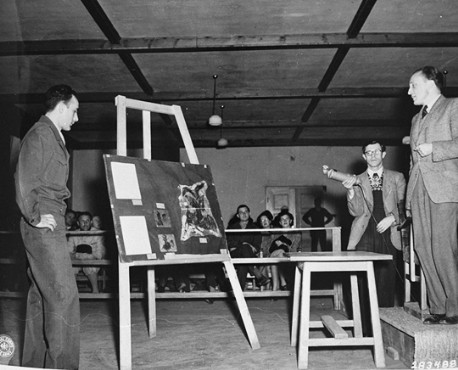
Prosecution witness
Dr. Kurte Sitte identifies 3 pieces of tattooed skin
Three pieces of tattooed skin and a shrunken
head were exhibited in the courtroom at Dachau as evidence of
the ghastly crimes committed by the staff at Buchenwald. The
photograph above shows Dr. Kurte Sitte, on the far right, who
is identifying the three pieces of tattooed skin, found in the
pathology department at Buchenwald. This same exhibit was shown
at the Nuremberg International Military Tribunal on December
13, 1945 as evidence of Crimes against Humanity.
According to the forensic report prepared for the trial, the
three pieces of skin were determined to be human. Joseph Halow,
a court reporter for some of the other Dachau trials, claims
that he saw a lamp shade that was part of the evidence at the
proceedings against Ilse Koch, but if this lamp shade was tested,
the results were not included in the forensic report. No one
else, that I know of, ever mentioned seeing a lamp shade in the
Dachau courtroom.
In the testimony given at Dachau, there
was no reference by any of the attorneys to a lamp being on display
in the courtroom during the proceedings. Dr. Sitte identified
the shrunken head that was exhibited in the courtroom, but he
did not mention a lamp being in the courtroom during his testimony.
Dr. Sitte, who had a Ph.D. in physics,
was one of the star witnesses against Ilse Koch. He had been
a prisoner at Buchenwald from September 1939 until the liberation.
He testified that tattooed skin was stripped from the bodies
of dead prisoners and "was often used to create lampshades,
knife cases, and similar items for the SS." He told the
court that it was "common knowledge" that tattooed
prisoners were sent to the hospital after Ilse Koch had passed
by them on work details. Dr. Sitte's testimony of "common
knowledge" was just another word for hearsay testimony,
which was allowed by the American Military Tribunal.
According to Joshua M. Greene, author
of "Justice at Dachau," Dr. Sitte testified that "These
prisoners were killed in the hospital and the tattooing stripped
off."
Under cross-examination, Dr. Sitte was
forced to admit that he had never seen any of the lampshades
allegedly made of human skin and that he had no personal knowledge
of any prisoner who had been reported by Frau Koch and was then
killed so that his tattooed skin could be made into a lampshade.
He also admitted that the lampshade that was on the display table
in the film was not the lampshade made from human skin that was
allegedly delivered to Frau Koch. Apparently the most important
piece of evidence, the lampshade made from human skin, was nowhere
in sight during the trial.
During his cross examination of Dr. Sitte,
defense attorney Captain Emanuel Lewis tried to introduce a plausible
explanation for the removal of tattoos at Buchenwald when he
asked:
"Is it not a fact that skin was
taken from habitual criminals and was part of scientific research
done by Dr. Wagner and into the connection between criminals
and tattoos on their bodies?"
Dr. Sitte answered:
"In my time, skin was taken off
prisoners whether they were criminal or not. I don't think that
a responsible scientist would ever call this kind of work scientific."
According to Joshua M. Greene, author
of "Justice at Dachau," the prosecution introduced
ten witnesses who testified against Ilse Koch. One of these witnesses,
Kurt Froboess, testified that he had seen Frau Koch's photo album,
which he said had a tattoo on the cover. He said that he had
seen this tattoo on a piece of preserved human skin, which he
said had been removed from a fellow prisoner, in the pathology
department at Buchenwald, and he later recognized this same tattoo
on the cover of the photo album.
Apparently this photo album was confiscated
by the American liberators, but it was not introduced into evidence
in the courtroom. In her plea for mercy from the court, Ilse
Koch pointed out that Newsweek magazine had published an article
in which it was stated that the US military government in Germany
was in possession of her photo album. Frau Koch claimed that
the album contained several photos of her home which showed lampshades
made from dark leather; Frau Koch said the photos showed that
the lampshades were clearly not made from human skin.
At least two witnesses testified about
a lamp with a shade fashioned out of human skin and a base made
from a human leg bone, which they claimed had been delivered
to Frau Koch. One of these witnesses, Kurt Wilhelm Leeser, testified
that he had previously seen the tattoos on this lamp shade on
the arms of a fellow prisoner, Josef Collinette, before he died.
This lamp was not introduced into evidence in the courtroom and
there were no witnesses from the American military who testified
about its existence.
The Jewish religion frowns upon tattoos
and a Jew who is tattooed cannot be buried in consecrated ground,
so it would have been unusual for a Jewish prisoner at Buchenwald
to have had a tattoo. It was pointed out by defense counsel that
Dr. Wagner was doing a study of tattoos and criminal behavior
at Buchenwald. Tattooed skin had been removed from dead criminals
and preserved at the pathology department where autopsies were
done.
The recent photograph below shows the
crematorium at Buchenwald. The pathology department was located
in the annex of this building. The black rocks in the foreground
outline where a barracks building once stood. The Buchenwald
concentration camp was built on the slope of a gentle hill and
all the prisoners could see the crematorium, with its tall smoke
stack, at the top of the hill. Unlike the layout of other camps,
such as Dachau and Sachsenhausen, the pathology department building
at Buchenwald was within plain sight of all the prisoners.
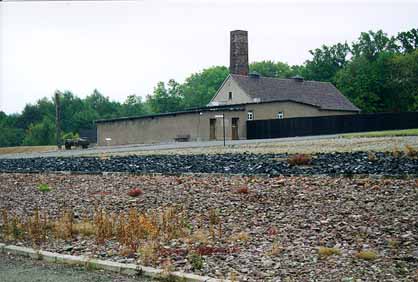
Crematorium and pathology
department at Buchenwald
Continue
Back
to Buchenwald trial
Back
to Buchenwald home page
Back
to Dachau Trials
Home
This page was last updated on September
16, 2009
Dachau TrialsUS vs. Josias Erbprinz zu Waldeck-PyrmontThe Trial of Ilse Koch  The most notorious German war criminal, of all those who were brought before the American Military Tribunals at Dachau, was unquestionably Ilse Koch, the wife of Karl Otto Koch, the infamous former Commandant of the Buchenwald concentration camp. Karl Otto Koch had already been put on trial by the Nazis themselves and executed before the war ended. Ilse Koch was among the 31 accused war criminals from Buchenwald who were brought before an American Military Tribunal at Dachau on April 11, 1947. Ilse Koch became pregnant while she was held in prison at the former Dachau concentration camp. The two photos above show how she lost weight during the trial; her baby was born in September 1947. Frau Koch had been previously investigated for 8 months by Dr. Georg Konrad Morgen, an SS officer who had been assigned in 1943 to look into accusations of corruption and murder in the Buchenwald camp. She had already been put on trial in December 1943 in a special Nazi Court where Konrad Morgan was the judge. The rumor, circulated by the inmates at Buchenwald, that lamp shades had been made out of human skin, was thoroughly investigated, but no evidence was found and this charge against Frau Koch had been dismissed by Morgen. Even though Ilse Koch had been acquitted in Morgen's court, the former inmates at Buchenwald were convinced that she had ordered prisoners to be killed, so that their tattooed skin could be made into lamp shades. When the American liberators arrived, they were told about the gory accessories in Frau Koch's home. A display table was set up and a film, directed by Billy Wilder, was made to document the atrocities in the camp. The photograph below is a still shot from the film. It shows preserved pieces of tattooed skin laid out on a table, and a table lamp with a shade allegedly made from human skin.  The story of the making of human lampshades at Buchenwald received a great deal of attention by the American press, and in the two years between the liberation of the camp and the start of the Buchenwald trial at Dachau, there had been considerable coverage in American newspapers. American soldiers who participated in the liberation of Buchenwald, including Harry Herder and Sgt. Blowers, had told horrible stories about the camp which they had learned from the prisoners. By the time the trial got underway, there was not the slightest doubt in the minds of most Americans that Ilse Koch was indeed guilty of this despicable crime. The following quote is from this web site. Sergeant Blowers told us some things about the Commandant of Buchenwald and his wife. We could see their house down the hill through the leafless trees from our seats on the front steps (of the barracks). Blowers painted a picture of truly despicable human beings. The wife, Ilse Koch, favored jodhpurs, boots, and a riding crop. He told us this story about her: Once, she ordered all of the Jewish prisoners in the camp stripped and lined up; she then marched down the rows of them, and, as she saw a tattoo she liked, she would touch that tattoo with her riding crop; the guards would take the man away immediately to the camp hospital where the doctors would remove the patch of skin with the tattoo, have it tanned, and patch it together with others to make lamp shades. There were three of those lamp shades--the history books say there were two, but there were three. One of them disappeared shortly after we arrived. This may give you a glimmer of an idea of what Ilse Koch was like--and her husband--and the camp "doctors." Ilse Koch testified that her home was near the zoo at Buchenwald, which means that her home was up the hill from the barracks, not "down the hill through the leafless trees" as described by Sgt. Blowers, which suggests that he and Harry Herder may not have been among the liberators of Buchenwald.  In the photograph above, taken on July 8, 1947, Ilse Koch points out the location of her home in the Commandant's house. In the lower left-hand corner of the map, the buildings shown in a semi-circle are the barracks of the SS soldiers. To the right, down the hill from her home, are the barracks for the prisoners. Lt. Col. Denson, the chief prosecutor, is standing to her left, with his back to the camera. Members of the press are sitting at a table on the left. An interpreter is standing to the right of Frau Koch. The courtroom had a capacity of 300 spectators, but as many as 400 people crowed into the room to hear the testimony in the Buchenwald case. The photograph below shows a group of American clergymen, who journeyed to the Dachau courtroom to witness the trial of "the Bitch of Buchenwald."  The International Military Tribunal at Nuremberg, which began on November 20, 1945 was based on Control Council Law No. 10 which included all war crimes committed by the Nazi regime against any and all nations and individuals between January 30, 1933, when Hitler was sworn in as Chancellor of Germany, and July 1, 1945. However, the American Military Tribunal proceedings against the staff at Buchenwald included only crimes committed against Allied nationals between January 1, 1942 and April 11, 1945, the day that Buchenwald was liberated. This was roughly the period of time during which America was at war with Germany. The charges against the accused in the proceedings of the American Military Tribunal did not include Crimes against Humanity, Crimes against Peace, nor War Crimes, as defined in Control Council Law No. 10 at the Nuremberg IMT. The Buchenwald camp had been in existence since July 1937, and Ilse Koch had been at the camp since August 1937, but there were no charges that involved crimes committed in the camp before January 1, 1942, nor were there any charges involving crimes committed against German citizens at Buchenwald. Any lamp shades made from human skin that came from prisoners killed at Buchenwald before January 1, 1942, if any existed, could not be included in the evidence against Ilse Koch at Buchenwald. Ilse Koch had previously been a secretary in Dresden until she became a female guard in the Sachsenhausen concentration camp near Berlin when it opened in 1936. Her future husband, Karl Otto Koch, was an SS officer who had been assigned to be the first Commandant of Sachsenhausen. In May 1937, Ilse became the second wife of Otto Koch, whose first marriage had failed. When Koch was transferred to Buchenwald to become the first Commandant there in August 1937, she accompanied him. Ilse Koch was born in 1906 and was nine years younger than her husband. Although the prisoners at Buchenwald had given her the title of Commandeuse, Ilse was nothing more than a housewife and mother of three children; she lived in the Commandant's house just outside the prison compound until she was arrested by the Nazis in August 1943 and taken to the jail in the nearby city of Weimar to await trial on charges of embezzlement and incitement to murder. After the war, Ilse Koch did not go into hiding, and after former prisoners in the camp told stories about her behavior to the American military, it was easy to track her down and arrest her as a war criminal. She was charged with participating in the "common design" to violate the Laws and Usages of war, but the specific charge against her was the horrific crime of selecting Buchenwald prisoners to be killed by her alleged lover, Dr. Waldemar Hoven, in order to have lamp shades made from their tattooed skin.  Three pieces of tattooed skin and a shrunken head were exhibited in the courtroom at Dachau as evidence of the ghastly crimes committed by the staff at Buchenwald. The photograph above shows Dr. Kurte Sitte, on the far right, who is identifying the three pieces of tattooed skin, found in the pathology department at Buchenwald. This same exhibit was shown at the Nuremberg International Military Tribunal on December 13, 1945 as evidence of Crimes against Humanity. According to the forensic report prepared for the trial, the three pieces of skin were determined to be human. Joseph Halow, a court reporter for some of the other Dachau trials, claims that he saw a lamp shade that was part of the evidence at the proceedings against Ilse Koch, but if this lamp shade was tested, the results were not included in the forensic report. No one else, that I know of, ever mentioned seeing a lamp shade in the Dachau courtroom. In the testimony given at Dachau, there was no reference by any of the attorneys to a lamp being on display in the courtroom during the proceedings. Dr. Sitte identified the shrunken head that was exhibited in the courtroom, but he did not mention a lamp being in the courtroom during his testimony. Dr. Sitte, who had a Ph.D. in physics, was one of the star witnesses against Ilse Koch. He had been a prisoner at Buchenwald from September 1939 until the liberation. He testified that tattooed skin was stripped from the bodies of dead prisoners and "was often used to create lampshades, knife cases, and similar items for the SS." He told the court that it was "common knowledge" that tattooed prisoners were sent to the hospital after Ilse Koch had passed by them on work details. Dr. Sitte's testimony of "common knowledge" was just another word for hearsay testimony, which was allowed by the American Military Tribunal. According to Joshua M. Greene, author of "Justice at Dachau," Dr. Sitte testified that "These prisoners were killed in the hospital and the tattooing stripped off." Under cross-examination, Dr. Sitte was forced to admit that he had never seen any of the lampshades allegedly made of human skin and that he had no personal knowledge of any prisoner who had been reported by Frau Koch and was then killed so that his tattooed skin could be made into a lampshade. He also admitted that the lampshade that was on the display table in the film was not the lampshade made from human skin that was allegedly delivered to Frau Koch. Apparently the most important piece of evidence, the lampshade made from human skin, was nowhere in sight during the trial. During his cross examination of Dr. Sitte, defense attorney Captain Emanuel Lewis tried to introduce a plausible explanation for the removal of tattoos at Buchenwald when he asked: "Is it not a fact that skin was taken from habitual criminals and was part of scientific research done by Dr. Wagner and into the connection between criminals and tattoos on their bodies?" Dr. Sitte answered: "In my time, skin was taken off prisoners whether they were criminal or not. I don't think that a responsible scientist would ever call this kind of work scientific." According to Joshua M. Greene, author of "Justice at Dachau," the prosecution introduced ten witnesses who testified against Ilse Koch. One of these witnesses, Kurt Froboess, testified that he had seen Frau Koch's photo album, which he said had a tattoo on the cover. He said that he had seen this tattoo on a piece of preserved human skin, which he said had been removed from a fellow prisoner, in the pathology department at Buchenwald, and he later recognized this same tattoo on the cover of the photo album. Apparently this photo album was confiscated by the American liberators, but it was not introduced into evidence in the courtroom. In her plea for mercy from the court, Ilse Koch pointed out that Newsweek magazine had published an article in which it was stated that the US military government in Germany was in possession of her photo album. Frau Koch claimed that the album contained several photos of her home which showed lampshades made from dark leather; Frau Koch said the photos showed that the lampshades were clearly not made from human skin. At least two witnesses testified about a lamp with a shade fashioned out of human skin and a base made from a human leg bone, which they claimed had been delivered to Frau Koch. One of these witnesses, Kurt Wilhelm Leeser, testified that he had previously seen the tattoos on this lamp shade on the arms of a fellow prisoner, Josef Collinette, before he died. This lamp was not introduced into evidence in the courtroom and there were no witnesses from the American military who testified about its existence. The Jewish religion frowns upon tattoos and a Jew who is tattooed cannot be buried in consecrated ground, so it would have been unusual for a Jewish prisoner at Buchenwald to have had a tattoo. It was pointed out by defense counsel that Dr. Wagner was doing a study of tattoos and criminal behavior at Buchenwald. Tattooed skin had been removed from dead criminals and preserved at the pathology department where autopsies were done. The recent photograph below shows the crematorium at Buchenwald. The pathology department was located in the annex of this building. The black rocks in the foreground outline where a barracks building once stood. The Buchenwald concentration camp was built on the slope of a gentle hill and all the prisoners could see the crematorium, with its tall smoke stack, at the top of the hill. Unlike the layout of other camps, such as Dachau and Sachsenhausen, the pathology department building at Buchenwald was within plain sight of all the prisoners.  ContinueBack to Buchenwald trialBack to Buchenwald home pageBack to Dachau TrialsHomeThis page was last updated on September 16, 2009 |